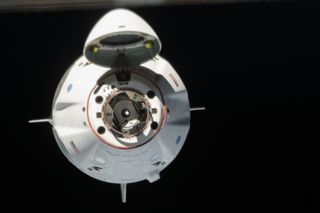Russian space chief weighs in on SpaceX's historic astronaut launch
Russian space chief weighs in on SpaceX's historic astronaut launch

The head of the Russian federal space agency Roscosmos published a lengthy op-ed expressing mixed feelings about the recent SpaceX Demo-2 launch to the International Space Station (ISS).
Dmitry Rogozin's op-ed, which is available on the Rocosmos website and was previously published in Forbes, points toward Russia's future plans in space as the United States moves most of its crewed opportunities back to American soil.
Demo-2 is the first of what will likely be many American crewed commercial spaceflights. Flights by SpaceX's Crew Dragon capsule and, eventually, Boeing's Starliner spacecraft should largely replace the Russian Soyuz missions that NASA astronauts have relied upon since the space shuttle's retirement in 2011.
In 2014, Rogozin tweeted out a memorable remark, saying that, as Russians faced U.S. sanctions related to Russian actions in Crimea, American astronauts could use a trampoline to reach space instead of the Soyuz.
Shortly after Demo-2's May 30 launch, SpaceX founder and CEO Elon Musk referenced this barb, saying "The trampoline is working!" Rogozin initially said on Twitter that he loved Musk's joke and looks forward to further cooperation. But the new op-ed shows that Rogozin had more to share about the way astronauts are launched to space and the framework of international space cooperation.
The Russians were asked to step in with Soyuz seats for astronauts, Rogozin said, because the space shuttle program was closed down "as the result of its immense costliness and unforgivable failure rate."
Each NASA space shuttle orbiter used to carry as many as eight people at a time, although seven was a more typical crew capacity. The Russian Soyuz spacecraft has a capacity of three people.
The space shuttle program flew 135 missions between 1981 and 2011. Two of those missions ended in tragedy: The shuttle Challenger exploded shortly after liftoff in January 1986, and Columbia broke apart during re-entry in February 2003. Each tragedy killed seven astronauts.
The Soviet Union (a predecessor entity to Russia) lost four cosmonauts across two Soyuz mission failures in 1967 and 1971. While the Russians have had no spaceflight fatalities since then, there have been aborts.
Most recently, a Russian Soyuz spacecraft experienced an abort in October 2018, after which the two crewmembers, NASA astronaut Nick Hague and cosmonaut Alexey Ovchinin, walked away with no serious injuries. Following an investigation, addressing the problem and several uncrewed rocket flights to test the fix, the ISS coalition decided to proceed with the next crewed Soyuz launch, which went off without a hitch in December 2018.
"In crewed spaceflights, with people going into space aboard the vehicles, reliability is key to evaluate these technical means ensuring safety of the crews," Rogozin wrote in the op-ed. "Thus, the closure [of the space shuttle] came as a predictable and forced measure, as the Americans lost as many as two crews. Disasters and emergencies have already occurred in crewed cosmonautics, but none of them took this many lives at once."
The Russian Soyuz MS spacecraft that carries crews today, Rogozin said, is the "world's most reliable spacecraft" with 173 successful flights, and three aborts in 1975, 1983 and 2018 that allowed the crews to eject safely. The Soyuz rocket that carries the spacecraft overall has more than 1,900 successful launches, he added. "The U.S. engineers have yet to earn this reputation. I sincerely wish them luck," he said.
Rogozin said that NASA was "hectically searching for a solution" to replacing the space shuttle, a process that ultimately took about 17 years after the fatal Columbia accident in 2003. In 2004, the administration of President George W. Bush announced that the shuttles would be retired.
Commercial crew replacements began taking shape under the administration of President Barack Obama, with SpaceX and Boeing receiving spacecraft build contracts in 2014 after several competitive rounds involving other companies. The first launch of a crewed commercial vehicle was delayed by several years due to technical and funding issues, but ultimately happened with Demo-2 on May 30 of this year.
Simultaneous to commercial crew, NASA began to sketch out plans to move farther out into the solar system once again. NASA began developing the deep-space Orion crew capsule, in partnership with prime contractor Lockheed Martin, during the Bush-era Constellation program.
Orion has continued development into the present day, even though NASA's exploration focus shifted a few times under other administrations — from a moon-to-Mars Constellation program (Bush) to a "flexible destination" somewhere in deep space (Obama) to a moon-focused Artemis program (Trump). Orion made a successful uncrewed test flight in 2014 around Earth and is expected to launch on a (much-delayed) uncrewed trip around the moon and back no earlier than 2021. This moon mission will mark the debut of NASA's Space Launch System megarocket, which is also key to NASA's deep-space plans
Comments
Post a Comment